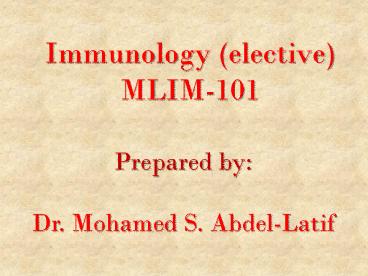Immunology (elective) MLIM-101 - PowerPoint PPT Presentation
1 / 25
Title:
Immunology (elective) MLIM-101
Description:
Immunology (elective) MLIM-101 Prepared by: Dr. Mohamed S. Abdel-Latif Learning Outcome: At this time you should know the following: 1. To compare and contrast ... – PowerPoint PPT presentation
Number of Views:118
Avg rating:3.0/5.0
Title: Immunology (elective) MLIM-101
1
Immunology (elective)MLIM-101
Prepared by Dr. Mohamed S. Abdel-Latif
2
Learning Outcome
At this time you should know the following 1.
To compare and contrast immunogen, antigen and
hapten 2. To describe the factors influencing
immunogenicity 3. To define the chemical nature
of immunogens 4. To compare the structures of
T-independent and T-dependent antigens 5. To
introduce the concept of hapten-carrier
conjugates and to describe their structure 6. To
characterize antigenic determinants 7. To
introduce the concepts of superantigens, PAMPs
and PRRs
3
Antigens
4
Overview of the Immune System
5
Definitions
- Immunogen
- Antigen (Ag)
- Hapten
- Epitope or Antigenic Determinant
- Antibody (Ab)
6
Factors Influencing ImmunogenicityContribution
of the Immunogen
- Foreignness
- Size
- Chemical Composition
- Primary Structure
- Secondary Structure
- Tertiary Structure
- Quarternary Structure
7
Factors Influencing ImmunogenicityContribution
of the Immunogen
- Foreigness
- Size
- Chemical Composition
- Physical Form
- Particulate gt Soluble
- Denatured gt Native
8
Factors Influencing ImmunogenicityContribution
of the Immunogen
- Foreigness
- Size
- Chemical Composition
- Physical Form
- Degradability
- Ag processing by Ag Presenting Cells (APC)
9
Factors Influencing ImmunogenicityContribution
of the Biological System
- Genetics
- Species
- Individual
- Responders vs Non-responders
- Age
10
Factors Influencing ImmunogenicityMethod of
Administration
- Dose
- Route
- Subcutaneous gt Intravenous gt Intragastric
- Adjuvant
- Substances that enhance an immune response to an
Ag
11
Chemical Nature of Immunogens
- Proteins
- Polysaccharides
- Nucleic Acids
- Lipids
- Some glycolipids and phosopholipids can be
immunogenic for T cells and illicit a cell
mediated immune response
12
Types of AntigensT-independent
- Polysaccharides
- Properties
- Polymeric structure
- Polyclonal B cell activation
- Yes -Type 1 (TI-1)
- No - Type 2 (TI-2)
- Resistance to degradation
- Examples
- Pneumococcal polysaccharide, lipopolysaccharide
- Flagella
13
Types of AntigensT-dependent
- Proteins
- Structure
- Examples
- Microbial proteins
- Non-self or Altered-self proteins
14
Hapten-carrier conjugates
- Definition
- Structure
- native determinants
- haptenic determinants
15
Antigenic Determinants Recognized by B cells and
Ab
- Composition
- Proteins, polysaccharides, nucleic acids
- Sequence (linear) determinants
- Conformational determinants
- Size
- 4-8 residues
16
Antigenic Determinants Recognized by B cells and
Ab
- Composition
- Size
- Number
- Limited (immunodominant epitopes)
- Located on the external surfaces of the Ag
17
Antigenic DeterminantsRecognized by T cells
- Composition
- Proteins (some lipids)
- Sequence determinants
- Processed
- MHC presentation (lipid presentation by MHC-like
CD1) - Size
- 8 -15 residues
- Number
- Limited to those that can bind to MHC
18
Superantigens
- Definition
Monoclonal/Oligoclonal T cell response 1104 -
1105
19
Superantigens
- Definition
- Examples
- Staphylococcal enterotoxins
- Staphylococcal toxic shock toxin
- Staphylococcal exfoliating toxin
- Streptococcal pyrogenic exotoxins
20
Determinants Recognized by the Innate Immune
System
- Adaptive Immune System Discrete Determinants
- Reacts with a specific pathogen
- Innate Immune System Broad Molecular Patterns
- Reacts with a variety of pathogens
21
Determinants Recognized by the Innate Immune
System
- PAMPs Pathogen Associated Molecular Patterns
- PRRs Pattern Recognition Receptors
22
PAMP PRR Biological Consequence of Interaction
Microbial cell wall components Complement Opsonization Complement activation
Mannose-containing carbohydrates Mannose-binding protein Opsonization Complement activation
Polyanions Scavenger receptors Phagocytosis
Lipoproteins of Gram bacteria Yeast cell wall components TLR-2 (Toll-like receptor 2) Macrophage activation Secretion of inflammatory cytokines
23
PAMP PRR Biological Consequence of Interaction
Double stranded RNA TLR-3 Production of interferon (antiviral)
LPS (lipopolysaccharide of Gram bacteria TLR-4 Macrophage activation Secretion of inflammatory cytokines
Flagellin (bacterial flagella) TLR-5 Macrophage activation Secretion of inflammatory cytokines
24
PAMP PRR Biological Consequence of Interaction
U-rich single stranded viral RNA TLR-7 Production of interferon (antiviral)
CpG containing DNA TLR-9 Macrophage activation Secretion of inflammatory cytokines
25
Assignment As a part of the semester activity,
group of students are selected every week to
prepare a short seminar about his/her point of
interest in one of the lecture topics. That to be
discussed and evaluated during the next lecture.































